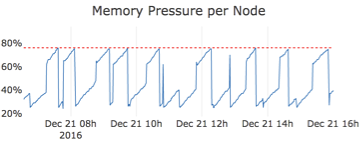ES JVM使用如果超过75%就会GC较多,导致ES索引性能下降
转自:https://www.elastic.co/guide/en/cloud/current/ec-metrics-memory-pressure.html
Scenario: How Does High Memory Pressure Affect Performance?
When you load up a cluster with an indexing and search workload that matches the size of the cluster well, you typically get the classic JVM heap sawtooth pattern as memory gets used and then gets freed up again by the garbage collector. Memory usage increases until it reaches 75% and then drops again as memory is freed up:

Now let’s suppose you have a cluster with three nodes and much higher memory pressure overall. In this example, two of the three nodes are maxing out very regularly for extended periods and one node is consistently hovering around the 75% mark where garbage collection kicks in.

High memory pressure works against cluster performance in two ways: As memory pressure rises to 75% and above, less memory remains available, but your cluster now also needs to spend some CPU resources to reclaim memory through garbage collection. These CPU resources are not available to handle user requests while garbage collection is going on. As a result, response times for user requests increases as the system becomes more and more resource constrained. If memory pressure continues to rise and reaches near 100%, a much more aggressive form of garbage collection is used, which will in turn affect cluster response times dramatically.

In our example, the Index Response Times metric shows that high memory pressure leads to a significant performance impact. As two of the three nodes max out their memory several times and plateau at 100% memory pressure for 30 to 45 minutes at a time, there is a sharp increase in the index response times around 23:00, 00:00, and 01:00. Search response times, which are not shown, also increase but not as dramatically. Only the node in blue that consistently shows a much healthier memory pressure that rarely exceeds 75% can sustain a lower response time.
If the performance impact from high memory pressure is not acceptable, you need to increase the cluster size or reduce the workload.





【推荐】国内首个AI IDE,深度理解中文开发场景,立即下载体验Trae
【推荐】编程新体验,更懂你的AI,立即体验豆包MarsCode编程助手
【推荐】抖音旗下AI助手豆包,你的智能百科全书,全免费不限次数
【推荐】轻量又高性能的 SSH 工具 IShell:AI 加持,快人一步
· 记一次.NET内存居高不下排查解决与启示
· 探究高空视频全景AR技术的实现原理
· 理解Rust引用及其生命周期标识(上)
· 浏览器原生「磁吸」效果!Anchor Positioning 锚点定位神器解析
· 没有源码,如何修改代码逻辑?
· 全程不用写代码,我用AI程序员写了一个飞机大战
· MongoDB 8.0这个新功能碉堡了,比商业数据库还牛
· 记一次.NET内存居高不下排查解决与启示
· 白话解读 Dapr 1.15:你的「微服务管家」又秀新绝活了
· DeepSeek 开源周回顾「GitHub 热点速览」
2016-12-19 JS模块式开发